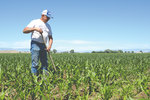Clear, 59° F
Last year, the farming season came in with wet and cold weather that delayed crops getting into the field. The summer brought in hail storms and floods that decimated acres of growing crops, and late …
This item is available in full to subscribers.
The Powell Tribune has expanded its online content. To continue reading, you will need to either log in to your subscriber account, or purchase a subscription.
If you are a current print subscriber, you can set up a free web account by clicking here.
If you already have a web account, but need to reset it, you can do so by clicking here.
If you would like to purchase a subscription click here.
Please log in to continue |
|


Last year, the farming season came in with wet and cold weather that delayed crops getting into the field. The summer brought in hail storms and floods that decimated acres of growing crops, and late season freezes forced farmers to leave tons of sugar beets in the ground.
This year’s planting season coincided with the COVID-19 pandemic, and it seemed as if farmers weren’t going to get a break.
Fortunately, at least so far, the weather has been going pretty easy on them.
“It’s quite encouraging,” said Lyle Evelo.
In the Powell area, Evelo grows sugar beets, sunflowers and barley. He also grows a niche crop of wheat known generally as ancient grains. With the warm spring weather, Evelo said all his crops are doing fairly well.
Jeremiah Vardiman, University of Wyoming Extension agriculture and horticulture educator in Powell, said the dry weather allowed most farmers to stay on a good planting schedule.
“The nice, dry spring helped with field preparation and planting,” he said.
Ric Rodriguez, who grows sugar beets out at Heart Mountain, said the year is looking better so far, but last year’s fall weather put some farmers behind. Farmers rotate last year’s barley fields into sugar beet fields, and getting those fields ready for the beet crops requires some fall work. While the spring has been nice, with the wet fall weather and the subsequent early freeze last year, some farmers were a bit behind.
Western Sugar Cooperative staff survey beet crops throughout the growing season. During their latest walkthrough of Rodriguez’s fields, he said they found a “mixed bag.” About a third of the beets were growing below average, a third were average, and another third were above average.
David Northrup, who farms on the Willwood, said his crops are doing really well this year.
“The corn is growing like a banshee, and the beets are coming up nice,” he said.
One downside to the dry weather is that it makes for an uneven barley crop, Northrup said. He had to “irrigate up” his fields and he’s seeing different growth rates on different parts of his acres. This past week brought out considerable moisture, which Northrup said will help address the issue.
“The rain will help even it out. Rain is the best irrigator there is,” he said.
Of course, it’s still early in the season, so it’s hard to say if the coming months will bring reasonable amounts of rain and warm temperatures; a single storm can come through in August and wipe out acres of crops. For the time being, however, things are looking up.
“You still have to gamble and hope for the best,” Northrup said.